
Lo Shiva è nato da un progetto di Robo Spitters (nella foto sopra), aquilonista olandese, che dal 1996 collaborava con la Cavaliers du Ciel.
Predecessore dello Shiva fu il Kick, aquilone che ebbe parecchio successo nelle competizioni:
Robo Spitters nel 1996 vinse l'Eurocup proprio con il Kick, nella foto sotto (tratta dal suo sito)
Robo vola con il Kick in una bella spiaggia olandese.

Insieme alla Cavaliers du Ciel Patrick Somelet sviluppa la versione ventata dello Shiva, caratterizzata dalla possibilità
di variare la ventatura con dei pannelli fissati alla vela con il velcro. Nella foto sotto si vede la parte sinistra con la massima
ventatura mentre la parte destra è "chiusa"; il range di vento di questa versione dello Shiva è da 15 a 45 km/h.

Altre foto dello Shiva ventato e "mezzo ventato" (foto dal sito di Patrick Somelet):
Qui sotto invece un bellissimo Shiva standard (foto di John Chilese):
Qui sotto un set di Shiva e gli Shiva del pair Shivadiva (dal sito di Randy Greenway)
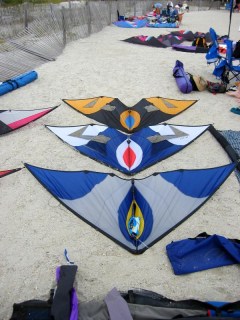
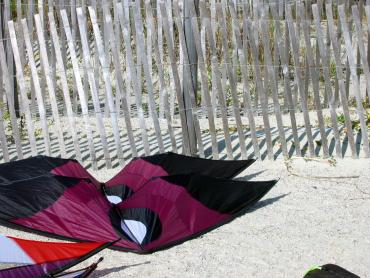
e aperto un laboratorio di tatuaggi a Rotterdam, oltre ai tatuaggi Robo oggi si occupa di biciclette piuttosto particolari.. vedi foto sotto (tratta dal suo sito):
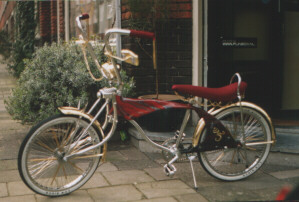
oltre a questo, arte, murales e registrazioni di bands musicali, vi consiglio una visitina al suo sito
Qui sotto altre foto dello Shiva:
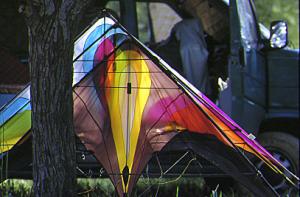
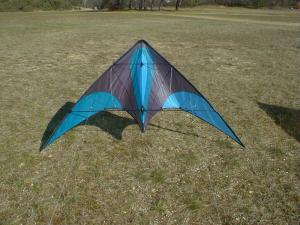
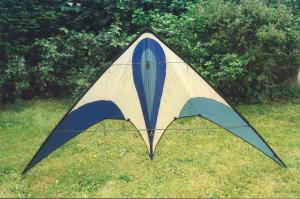
Da sinistra Shiva family foto di Patrick Somelet, Shiva competition di Alain Jouny e Shiva UL di Philippe Doré
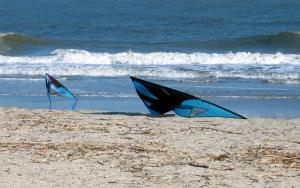
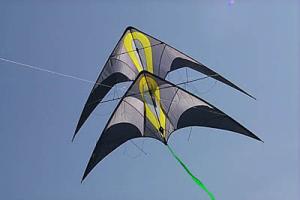

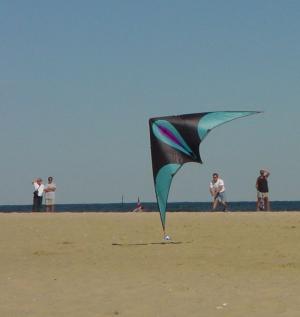
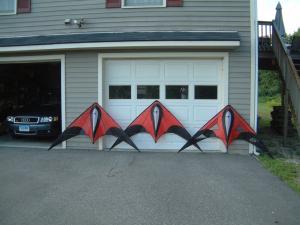
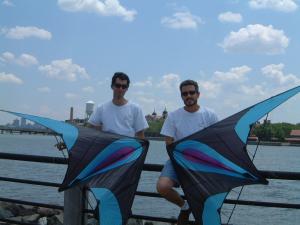
Qui sopra tre foto inviatemi da Ron Graziano, aquilonista americano che con lo Shiva ha vinto parecchie competizioni: 1° posto Master ballet & Master precision per la US Coast nel 2001 e 2002 campione nazionale AKA in Master individual ballet. Nella foto a sinistra Ron vola al festival
di Belmar, New Jersey. Al centro il set di Shiva che Ron usa per le competizioni individuali. A destra il pair Wright Brothers, Ron Graziano
& Ari.
Qui sotto i "tips" di Ron Graziano per settare al meglio lo Shiva, in particolare per renderlo più performante nei tricks:
Ron Graziano's Shiva Tuning Tips
These are a set of small changes I make to my Shivas to get even better performance out of them. They are easy to do, so give them a try!
1. Spreader position:
I've seen Shivas with the lower and upper spreader connectors in slightly different positions. On some, the connector is centered within the leading edge cutout. On others, it's towards the bottom of the cutout, and others towards the top. I've also seen some variation on the size and positioning of the cutout. I get the best slack-line performance with the LLE connector pushed up almost to the top of the cutout, and the ULE connector pushed towards the bottom of its cutout. This opens the wings up a bit and increases the aspect ratio. Remember to pry the C-clip stops loose and move them as well. The positions of the connectors should be:
* Nose to bottom of the upper leading edge spreader connector (APA fitting): 38 cm
* Bottom of upper leading edge APA to bottom of lower leading edge APA: 66.5 cm
* Bottom of lower leading edge APA to end of wingtip nock: 56.5 cm
2. Bridle configuration:
The Shiva has a pretty basic, fairly long turbo bridle. But on the newer models, you'll notice an additional line added. At the upper leading edge connector, there will be 2 lines attached. One is attached at the other end to the lower leading edge connector, and is an integral part of the bridle. The other line is attached with a larkshead at the other end to the inhaul (bridle line that runs to the center-T). I remove this line. Just disconnect it from the pigtail at the upper leading edge connector, and undo the larkshead where it attaches to the inhaul line. This additional line was added to the bridle to prevent a problem common to many kites with long turbo bridles - the bridle can wrap around the tip of the spine and prevent you from launching. That really hurts, especially in competition (see my solution to this in #3). The problem is that I've found this additional line can inhibit some tricks - makes cascades a bit more difficult, and really slows flic-flacs. So I just take the line off and fly with the basic turbo bridle. Much better, in my opinion.
3. Trick line:
If you follow my advice in Tip #2, you're going to have to do something about the bridle occasionally snagging on the tip of the spine. I added a simple "V" style trickline to my kites for this. I don't find wingtip wraps to be a problem with the Shiva, so I wanted to add the most minimal line possible. What I do is burn 2 very small holes in the velcro flap that covers the end of the spine, and put a small loop of bungee through each (make sure the knot in the bungee is buried under the flap, leaving it exposed can create other snag problems). Then, I tie a length of Spectra (150# is plenty) to the bungee, and run it down to the sail-stay on the outer standoff and tie it off here. Do this on both sides of the kite. The "V" style line prevents the spine-wraps, and still allows the lines to get close to the kite for turtles and lazy susans. The bungee is important since it allows the trick line to stretch, thus allowing the wings to flex (which is what they need to do in flight). Tie the line initially so that it stretches the bungee just a little bit.
4. Upper Spreader
I've found that the Shiva Comp. does fade/flic-flac maneuvers better with a slightly heavier upper spreader. The stock upper spreader is an Avia .2100 rod, I replace it with a .2200. The added weight changes the balance just enough to help the tricks without hurting precision in any way. I have only seen this on the Shiva Comp. - the SUL and Vented seem fine with the stock upper spreaders.
5. Bridle settings
I find the Shiva bridle to be good only within a fairly narrow range, maybe 1/4" in each direction. Beyond that, I don't like the effect on the kite. Bear in mind that I'm not much of a bridle geek to begin with, so there may be other bridle tweaks that I'm not thinking of. I tend to keep my Shiva Comps set up a little heavier (nose back) than factory setting - maybe 1/8" down from the factory mark. My SULs get set a little lighter (nose forward) than factory, again maybe by 1/8". The Vented usually stays right on the factory mark.
6. Sail Tension
I don't like to tighten the Shiva sail too much. Tighten the leading edge tension line just enough to take the wrinkles and puckers out of the leading edge, but no more. I keep no tension at all on the leach line . I tend to keep my Shivas looser than some other folks, and they may make a little noise in moderate wind, but I prefer the way they fly. The noise from the trailing edge is acting as a dynamic brake as the wind picks up, helping to control the speed and pull of the kite.
Grazie a Ron Graziano per avermi permesso di pubblicare questo suo interessante documento.
Oggi lo Shiva è prodotto in ben 5 versioni: ultra light, standard, competition, 1/2 ventato e ventato, per coprire qualsiasi range di vento da 0,5 a 45 km/h.
E' ancora molto usato nelle competizioni in particolare da pairs e team.
Ecco qualche sito dove trovare altre info su questo aquilone:
http://www.urbandelights.nl
il sito di Robo Spitters, c'è una pagina dedicata agli aquiloni
da lui progettati.
http://perso.wanadoo.fr/patrick.somelet/cerf_volant_parap.html questo è il sito di Patrick Somelet, non è + aggiornato dal 1999 ma è funzionante e molto interessante!!
http://perso.wanadoo.fr/patrick.somelet/cerf_volant_parap.html questo è il sito di Patrick Somelet, non è + aggiornato dal 1999 ma è funzionante e molto interessante!!
http://www.cavaliersduciel.com/gamme/pilotables/shiva/shiva.htm#2
in questa pagina del sito Cavaliers du Ciel trovate le schede
tecniche di tutte le versioni dello Shiva.
http://www.kites.org/jo/reviews/shivareview.html qui c'è una recensione in inglese dello Shiva (e di tanti altri acrobatici)
http://www.chilese.com/index.cfm/photos.html?album_id=7A52DA8B-D7C3-11D6-800F-0004AC4C1EA1 nel Sito dell'aquilonista americano John Chilese ci
sono, fra le atre, alcune bellissime fotografie dello Shiva, vi consiglio comunque di guardarvi anche gli altri album del sito sono davvero bellissime foto.
Un grandissimo grazie a Robo Spitters, Patrick Somelet , John Chilese, Randy Greenway, Alain Jouny, Michel Rohé, Philippe Doré, Ron Graziano per avermi dato il permesso di utilizzare le foto presenti in questa pagina, tratte dai loro siti e avermi mandato foto dei loro aquiloni. Merci beaucoup Patrick, Alain, Michel et Philippe. Thanks a lot Robo, John, Randy & Ron!
http://www.kites.org/jo/reviews/shivareview.html qui c'è una recensione in inglese dello Shiva (e di tanti altri acrobatici)
http://www.chilese.com/index.cfm/photos.html?album_id=7A52DA8B-D7C3-11D6-800F-0004AC4C1EA1 nel Sito dell'aquilonista americano John Chilese ci
sono, fra le atre, alcune bellissime fotografie dello Shiva, vi consiglio comunque di guardarvi anche gli altri album del sito sono davvero bellissime foto.
Un grandissimo grazie a Robo Spitters, Patrick Somelet , John Chilese, Randy Greenway, Alain Jouny, Michel Rohé, Philippe Doré, Ron Graziano per avermi dato il permesso di utilizzare le foto presenti in questa pagina, tratte dai loro siti e avermi mandato foto dei loro aquiloni. Merci beaucoup Patrick, Alain, Michel et Philippe. Thanks a lot Robo, John, Randy & Ron!